
 |
 |
Science
Olympiad
| Division (Phylum) Sphenophyta | |
The horsetails (phylum Sphenophyta or Equisetophyta) range from the Devonian to recent times. Equisetum is the only extant (living) genus (Willis & McElvain, 2002, p. 104). The species representing this genus are all small herbaceous plants. Horsetails have jointed stems with vertical ribbing. All the branches, leaves and cones are borne on whorls (Kenrick & Davis, 2004, p. 89). Like the lycopsids the sphenopsids are vascular plants with true roots, stems, and leaves. Both groups of plants reproduce with spores. Horsetails (sphenopsids) are closely related to ferns. Some taxonomists place the sphenopsids in the fern division Pteridophyta, as is the case with the 2015 Science Olympiad Fossil List. When placed within the fern division, horsetails are grouped in the class Equisetopsida or Sphenopsida. Carboniferous Forests The first major coal deposits were formed during the Carboniferous. Within the coal measures are found thin marine sediment layers, which may represent interglacial periods (Kenrick and Davis, 2004, p. 81) or the periodic deposition and erosion of delta lobes (Selden and Nudds, 2004, p. 59). The large coal deposits in the eastern U.S. and Western Europe formed between 295 and 320 mya. These coal-forming forests grew in humid, tropical environments. Lycopsids (clubmosses) and sphenopsids (horsetails) would reach their greatest diversity in these Carboniferous forests, which have no analogues today (Kenrick and Davis, 2004, p. 35). Lycopods (Lycophyta) represented the dominant tree form. However, arborescent forms of sphenopsids also formed a significant portion of the organic matter in late Carboniferous coal measures (Willis & McElwain, 2002, p. 107). Wet, humid environments are needed to complete the life cycles of both nonvascular plants and spore producing vascular plants. In the life cycle of plants a gametophyte (haploid) generation alternates with a sporophyte (diploid) generation. Seedless vascular plants such as lycopods, sphenopsids, and ferns possess structures that produce spores dispersed by wind. These spores are more drought-resistant than the non-vascular plants like mosses and liverwarts. The spores grow into small, inconspicuous gametophyte plants that possess one set of genetic instructions (haploid). Gametophyte plants have structures that produce sperm or eggs. Water is required for the sperm to swim to and fertilize eggs, forming zygotes. Zygotes with two sets of genetic instructions grow into the large sporophyte plants. Ancient Horsetail Trees Several arborescent sphenopsids are known from the Carboniferous to the Permian. Calamites was the largest horsetail tree. Calamites grew up to 18 m in height (Willis & McElwain, 2002, p. 104). Calamites stems were segmented. The joints of the segmented stem are referred to as nodes. Arborescent horsetail trunks had a ring of woody tissue surrounding a hollow interior, which gave the effect of a reinforced tube. This design was fast growing and used minimal material for strength. Trunks of this type are prone to buckling at branching points, so branches are constructed at small angles. Overall, branching is sparse in the tree design (Kenrick & Davis, 2004, p. 70). Branches and whorled leaves sprouted at the joints or nodes. Leaves were both needle-like and lanceolate (bladelike). In our article we use Calamites to describe the entire plant. However, the genus Calamites was intially used only for pith casts of the stem. Different organs of Calamites, like many other Carboniferous plants, were given seperate names before it was known that they represented one plant. The whorled leaves are known as Annularia and Asterophyllites. The trees grew from a creeping rhizome. Roots and root hairs also grew from the horizontal rhizomes. Roots are known as Astromyelon (Rich, 1996, p. 385). Spores grew in sacs organized into cones known as Calamostrachys and Paleostachya. Casts of the pith cavity (Calamites) are a common fossil. The most common calamitean petrified stem is known as Arthropitys. Today, the genus Calamites is often used to encompass the stem, pith, and central canal (Taylor, Taylor, and Krings, 2009, p. 345). It is believed that Calamites did not form an undestory to the lycopsids, but grew in clearings or on waterside edges of forests (Willis, & McElwain, 2002, p. 107). Science Olympiad Fossil Event The 2016 Science Olympiad Fossil List includes the genus Calamites (Horsetail) and the plant leaf Annularia within the phylum Pteridophyta (Ferns). |
|
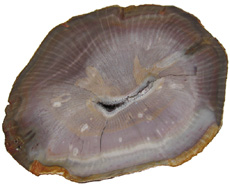 Arborescent Horsetail Calamitean stem Arthropitys Bieland, Maranhao Province, Brazil Pedra de Fogo Formation Permian 10.5 cm x 8 cm |
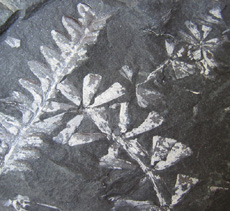 Sphenophyllum sp. Center & Upper Right (maybe related to horestails) Plate 6.5 cm x 5 cm |
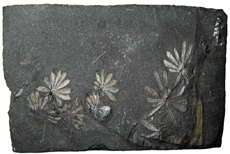 Annularia radiata Upper Carboniferous, Westfalien Piesberg/Osnabruck, Germany Plate 7 cm x 4.7 cm |
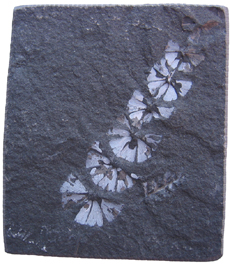 Sphenophyllum sp. Upper Carboniferous, Westfalien Piesberg/Osnabruck, Germany Plate 6 cm x 5.2 cm |
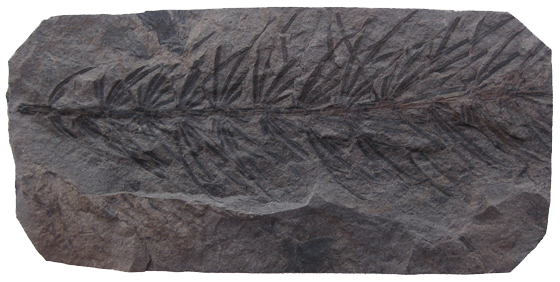 Asterophyllites equisetiformis Carboniferous (Stephanian) Graissessac, Herault, France Plate 10.5 cm x 5.5 cm |
|
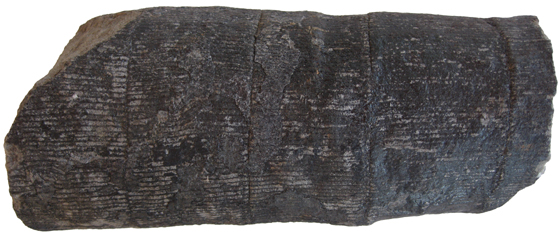 Calamites Pith Cast Carboniferous West Virginia 16 cm long x 6.5 cm diameter |
|
Bibliography |
|
| Kenrick,
P. and Davis, P. (2004). Fossil Plants. Smithsonian
Books: Washington. Selden P. & Nudds, J. (2004). Evolution of Fossil Ecosystems. Chicago: The University of Chicago Press. Rich P.V., Rich T. H., Fenton, M.A., & Fenton, C.L. (1996). The Fossil Book: A Record of Prehistoric Life. Mineola, NY: Dover Publications, Inc. Willis, K.J. & McElwain, J.C. (2002). The Evolution of Plants. New York: Oxford University Press. |
|










